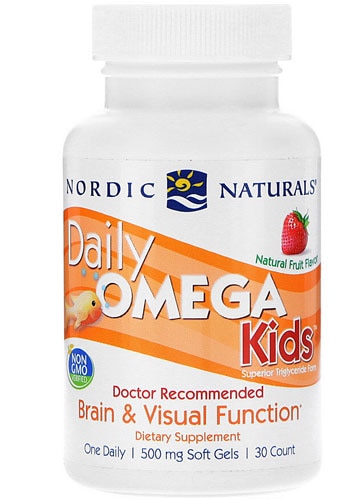A thick salmon steak or slice of anchovy pizza might not be your child’s favorite things on the menu, but you’d be wise to try to find a way to get her to dig in. Fish is not only a good source of protein and smart addition to a heart-healthy diet, but it delivers essential fatty acids (EFAs) that can be tricky to find in kid-friendly dishes. Not made by the body, but a must for health, EFAs need to be obtained from the foods we eat.
Why are essential fatty acids important?
EFAs play a number of important roles in health, including helping to maintain a healthy inflammatory response, providing cardiovascular support, supporting cognitive health, mood, memory and more.*
For children, they are vital for brain and eye development and function.*
How can I obtain essential fatty acids?
The most well-known type of EFAs are omega-3s, which include eicosapentaenoic acid (EPA) and docosahexaenoic acid (DHA). They can be found in fatty fish, such as salmon, sardines, mackerel, tuna, trout, herring and halibut, as well as in oysters and shrimp.
Two other types of EFAs include linoleic acid (LA) and alpha-linolenic acid (ALA), and they’re commonly found in plant foods like flaxseed, walnuts, spinach, soybeans and pumpkin seeds. The body needs to covert LA and ALA into DHA and EPA, the more usable forms of these essential fats. Conversion, however, is minimal, making it your best bet to consume omega-3 fatty acids from bioavailable food sources such as fish.
Food vs. supplements
When deciding between supplements or getting nutrients through food, always choose food whenever possible. The absorption of nutrients from food is typically better than with supplements, and you receive other nutrients from food that you might not get from a supplement.
For example, by eating fish, you’re getting essential omega-3 fatty acids and protein, which isn’t included in a fish oil supplement.
If you or your child aren’t eating enough fish or the plant foods mentioned above, supplements are a good alternative.
What are the recommended amounts of fish oil for kids?
The 2015 Dietary Guidelines for Americans recommends that children 2 to 8 years old should eat 3 to 6 ounces of fish per week. Children age 9 years and older should eat 8 to 10 ounces of fish per week.
In supplement form, the following amounts of fish oil for kids are suggested:
- 0-12 months: 0.5 grams/day (this is often received through breast milk and fish-oil fortified formula)
- 1 to 3 years: 0.7 grams/day
- 4 to 8 years: 0.9 grams/day
- 9 to 13 years (boys): 1.2 grams/day
- 9 to 13 years (girls): 1.0 grams/day
- 14 to 18 years (boys): 1.6 grams/day
- 14 to 18 years (girls): 1.1 grams/day
Tips for choosing fish oil supplements
When selecting a fish oil supplement, look for a brand that certifies their products as free of heavy metals, such as mercury, lead and cadmium through a process called molecular distillation.
Be sure to check the expiration date to minimize the risk the product has gone rancid. A quick test at home to gauge the quality fish oil is to break open a capsule—there should be no strong, fishy odors or “rotten” smell.
Liquid or capsule forms of omega-3s are best. Check that main ingredient is fish oil and not a filler oil.
Use caution when choosing a chewable fish oil supplement, as it may contain lower amounts of EPA and DHA and contain added sugar.
Overall, fish intake and fish oil supplementation have been shown to have many positive effects on health. When deciding which omega-3 fatty acids source is best for you and your children consider consulting a registered dietitian and your child’s pediatrician before making big changes in diet and supplementation.
*These statements have not been evaluated by the Food and Drug Administration. These products are not intended to diagnose, treat, cure or prevent any disease.
This article was contributed by the registered dietitian nutritionists with The Little Clinic (inside select Kroger locations). For more information about dietitian services, visit www.thelittleclinic.com/dietitians.




